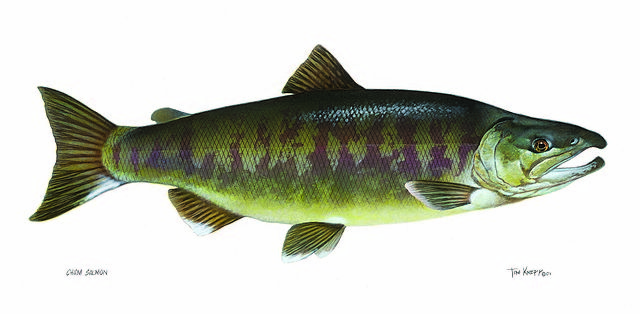Species Spotlight: Top 10 fishes of the Pacific Northwest
November 3, 2021
The Pacific Northwest’s pristine Pacific Ocean and clear running rivers are a gorgeous staple of our home. But have you ever wondered what lies beneath the water’s surface? In the third installment of Species Spotlight (following frog review and salamander review), we take a look at one of the Pacific Northwest’s most iconic creatures: fish.
The following fish are ranked from worst (10) to best (1).
10: Chum Salmon
Coming in at number 10, the chum salmon is a fish that can be found all over the world. They have the largest natural range of any Pacific salmon (meaning that, of all the Pacific salmon, they have spread out across the world the most without human help). They are found fairly close to the surface of the water, rarely diving below 50 feet. Despite being easy to catch, most fishermen don’t go for them because they have an exceptionally low market value. Sadly, they don’t make it far up the list because they aren’t unique, but they do get extra points because their sleek shape and funny are classic fish design.
The smallest fish on the list thus far, the pumpkinseed sunfish is anywhere between 10-28 centimeters in length and weighs less than a pound. This fish is exceptionally adaptable. Living in generally calm waters, the pumpkinseed will dive to the very bottom of lakes to feed on small fish or stay close to shore depending on what yields the best results. They swim in schools of other small sunfish. Basically, they can be found anywhere and everywhere in freshwater habitats, which is a nuisance to fishermen, who commonly catch pumpkinseed sunfish accidentally. Their adaptability and groovy skin pattern solidifies their place on the list.
Before reading this particular review, please note that this applies to every white sturgeon besides Herman the Sturgeon, Oregon’s favorite fish.
The white sturgeon is a big grey fish native to the West Coast. It is a mostly grey or brown fish and can be found pretty much anywhere along the West Coast. They usually are around 3-5 feet long, but they have been found at 20 feet long in rare instances. The white sturgeon is basically what you think of when you hear “fish,” like the type that a frat bro holds up in his Tinder profile picture. White sturgeon also make caviar that can be illegally sold by poachers for about $150-200, but most of the time it’s sold for $700 legally, so it sadly can’t uphold its own black market. The most interesting thing about the white sturgeon is the fact that it can live up to around 100 years old, but when it doesn’t do much for those hundred years that really isn’t an alluring trait, which is why it is dropped at number 8 on my list.
The sockeye salmon is an aggressive, spiffy-looking fish. Whenever large schools of these fish migrate to lay eggs, their skin turns from having a bluish tint to having a bright red skin and green face. Once at the spawning grounds, the males assert a hierarchy based on who is the chunkiest fish. This hierarchy is maintained through strength, with the biggest males aggressing insubordinate fish or other sockeye salmon vying for a higher place in the hierarchy. These fish mostly earn their spot on the list because they change colors when they go to their breeding grounds, but I also like the idea of fish throwing hands, or rather, fins.
The rainbow trout is a snazzy fish, both in appearance and its role in ecosystems. When you first look at this fish, you notice its oil slick skin, shining like a fresh pair of Pit Vipers. The most interesting thing about this fish is how delicate it is; The rainbow trout can only survive in freshwater, so when ecologists monitor it they can see how pure a body of water is based on whether or not rainbow trout stick around. This is a solid fish with vibrant colors.
The vermillion rockfish is a giant orange highlighter. This bad boy is two and a half feet of shimmering orange scales and not much else. It is sedentary, tending to hide in coves underwater, and it doesn’t have many unique traits to it. The only reason why it isn’t lower on the list is because I wholeheartedly believe that this fish is buff Nemo.
Coming in at only about 9 inches long and not even 2 pounds, the white crappie isn’t crappie at all. Its skin is more silver than white, with stripes running down the sides of its body and a funny-looking forehead. When you factor in the funny name, all of these traits culminate to create a fish worthy of being number four on my list.
The quillback rockfish is the eternal punk of the sea. It has dark skin, large black eyes and a mohawk of giant, venomous spines riding down its back. Like all Rockfish, the Quillback stays close to the bottom of bodies of water. In order to do so, it uses a water bladder, an organ that holds oxygen to allow fish to change how close they are to the surface of the water without sinking too low or floating too high. Overall, I really like the Quillback. The spikes on its back might not be deathly, but they are still dangerous (can give you a bad rash, sort of like an aggressive cat scratch). More importantly, the Quillback Rockfish found its aesthetic and committed, giving it bonus points in my book.
2: Cabezon
The cabezon is a big boy in every sense of the word. As noted by its name, this fish has a giant head (cabezon means big head in Spanish). They reach over three feet in length and weigh 31 pounds. The Cabezon has both poisonous spines running down its back and poisonous eggs. Basically, this fish is the embodiment of “Toxic” by Britney Spears. This fish makes it so high on the list because of its funny face. The close-set eyes on the ballooned head make this fish so unbelievably comical, and that alone makes it worthy of second place.
1: Opah
There are 171,476 words in the Oxford English dictionary and yet no string of them can accurately describe how much joy the Opah brings me. This behemoth of a specimen is shaped like a giant frisbee, but has little fins sticking out of its sides that look like penguin wings. Its face is the most sincere and innocent thing on the planet, and last but not least, the Opah’s body is covered in shiny polka dots. But don’t be fooled, this large lad isn’t all looks. The Opah has a unique trait called endothermy, which means that it can warm its body and internal organs by about 10 degrees on command, allowing them to swim deep underwater for food without dying from the cold. Other fish exhibit endothermy, but generally not to the same degree as the Opah. The Opah is an astounding fish all around and easily takes the number one spot on my list.
Fish are funky and fascinating. There are so many more species living in the ocean and rivers around us, just waiting to be learned about. Look them up, or better yet go outside and see the wonders of the Pacific Northwest (such as fish).





Sturgeons of America • May 19, 2023 at 1:55 pm
Sturgeon put far too low on the list. This list is frankly an insult to the fish community as a whole. The sheer power of the sturgeon is not to be ignored as the #1 fish of the north west. It also tastes like fishy chicken which is super cool. Overall the sturgeon is incredibly based and this list is as insulting as it is ignorant.
Shail • Nov 5, 2021 at 3:59 pm
Very well written article. I must say I am a bit outraged about the placement of the sturgeon. It deserved top 3 at the very least. However besides that I look forward to the next literary masterpiece the author writes.
A Sasquatch • Nov 4, 2021 at 11:24 am
Can we please have a cryptids list next?? I love the species spotlight series and I think it would be such a great way to expand the series! Can’t wait to see more!
Rubie • Nov 4, 2021 at 10:09 am
Fantastic article, but Pumpkinseed sunfish are cooler than rainbow trout.
Joe Biden • Nov 4, 2021 at 8:32 am
Incredibly disappointed with the white sturgeon’s placement on this list, especially the deliberate decision to not capitalize its name. Pray tell: how does a fish named “white crappie” beat out THE white sturgeon?? Really calls into question the integrity of this writer, whoever he may be, wherever in the world he may be in. Delightful article otherwise
White Sturgeon Activist • Nov 4, 2021 at 8:30 am
Incredibly disappointed at the white sturgeon’s placement on this list, as well as the deliberate decision to not capitalize its name. Pray tell: how does a fish named “white crappie” score higher than THE white sturgeon? The rest of the article is a delight, but this fundamental flaw in the article makes me question the integrity of the author, whoever he may be.
Lucia • Nov 3, 2021 at 10:01 pm
Very well-written article. Though I heartily disagree with the sturgeon’s place on the list, I will make peace with it, eventually. Would love to see the next top 10 list in the physical paper, that’d be awesome! Keep up the fantastic work Mr. Adams
Sam J • Nov 3, 2021 at 8:47 pm
I disagree with sturgeon place so low on this list. Such disrespect for a huge dinosaur 100-year old anadromous fish that accidentally eats salmon from time to time. Frat boy comparison to sturgeon was way out of line! I’m really working hard here to not to swear here.
Amelia • Nov 3, 2021 at 8:35 pm
What’s the head of the underwater mafia called?
The Codfather.
Ollie • Nov 3, 2021 at 6:35 pm
Opah, more like Opah Gangam Style!! Amazing article
Lia • Nov 3, 2021 at 5:06 pm
Not only is this article informative, but it is also incredibly hilarious! I did not expect to enjoy reading a fish ranking so much, but whoever this “Owen Adams” kid sure makes a good Species Spotlight. I would love to see a mushroom ranking in the future. Or perhaps even cryptids? – A satisfied reader
Ava • Nov 3, 2021 at 5:04 pm
This is the best article I’ve ever read. Whoever wrote it should be very proud.
A White Sturgeon • Nov 3, 2021 at 4:21 pm
In my opinion the sturgeon should have been rated much higher. The size they can grow to, the average lifespan they have, and their abundance was mentioned, but completely blown off. Not to mention the author left out many important factors such as their strength and usefulness to the local wildlife (in which the author wrote “it doesn’t do much” which is entirely incorrect). The white sturgeon was completely overlooked and obviously written off of a bias rather than written off of research. Overall, a fine piece piece of writing, if you don’t take into account the major lack of research and thought put into it.
Julian • Nov 3, 2021 at 4:03 pm
Another banger by Owen Adams. This series is amazing and I’m always so excited when they come out. Kinda disappointed that it didn’t make it in to the paper, hopefully we see that in the future!
Julian • Nov 3, 2021 at 4:02 pm
Another banger by Owen Adams. This series is amazing and I’m always so excited when they come out. Kinda disappointed that it didn’t make it in to the paper, hopefully we see that in the future!
A White Sturgeon • Nov 3, 2021 at 3:58 pm
In my opinion the sturgeon should have been rated much higher. The size they can grow to, the average lifespan they have, and their abundance was mentioned, but completely blown off. Not to mention the author left out many important factors such as their strength and usefulness to the local wildlife (in which the author wrote “it doesn’t do much” which is entirely incorrect). The white sturgeon was completely overlooked and obviously written off of a bias rather than written off of research. Overall, a fine piece piece of writing, if you don’t take into account the major lack of research and thought put into it.
siri • Nov 3, 2021 at 3:24 pm
good.
Ava • Nov 3, 2021 at 3:21 pm
This is the best article I’ve ever read. Whoever wrote it should be very proud
Jasmine • Nov 3, 2021 at 3:12 pm
The cabezon was my favorite and should have definitely won. Also, you should do top ten mosses or top ten worms next.
Trotter • Nov 3, 2021 at 3:06 pm
This is the best article I’ve ever read. Whoever wrote it should be very proud
Julian • Nov 3, 2021 at 4:00 pm
Fr